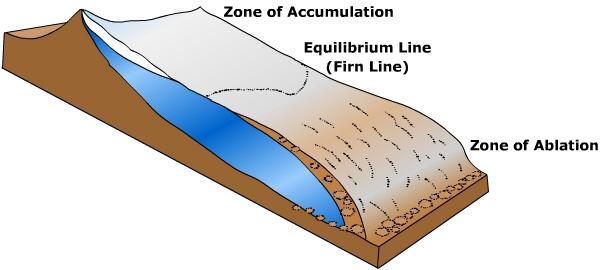
It would be remiss of us to speak of Louis Agassiz without first mentioning the study of glaciers and ice, i.e. glaciology. Glaciology is an interdisciplinary Earth Science with that integrates geophysics, geology, physical geography, geomorphology, climatology, meteorology, hydrology, biology, and ecology. It goes without saying that in Louis Agassiz’s time, this field was not so broad as glaciology was still in its infancy.
Glaciology is primarily concerned with the positions of glaciers with respect to the topography of the earth. Thus glaciers are divided in two types: alpine and continental. In the time of Louis Agassiz continental glaciers were only thought to have existed only within the Arctic Circle, Greenland, and Antarctica. This is due to the fact that the concept of a global ice age had not yet been proposed.
To understand glacial advance and retreat, one must first understand how glaciers move. The following are some important terms that one should know: zone of accumulation and zone of ablation.
- Zone of accumulation: This zone is above the glacier equilibrium line. In this area of a glacier, snowfall accumulates and exceeds the masses lost from ablation (removal of material from a glacier through melting, evaporation, sublimation, and erosional processes such as calving). This leads to glacial advance, due to more material being added to the glacier.
- Zone of ablation: This zone is below the glacier equilibrium line. In this zone of a glacier, the rate of ablation is greater than the rate of accumulation. Thus, the glacier retreats, as more material is lost than added.

Armed with this knowledge we can understand some glacial theory. Throughout geologic history, the Earth has been subjects to several ice ages in a cyclical pattern. In Agassiz’s time, this was still uncharted territory. To us, it may seem almost intuitive that climate is subject to cycles and patterns, but it is important to remember that this knowledge is relatively new.